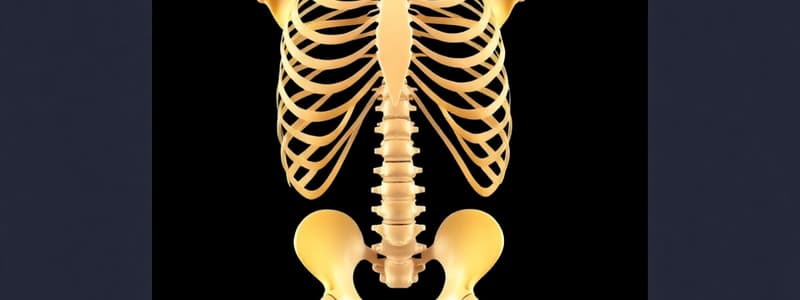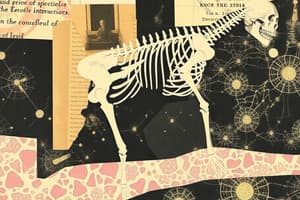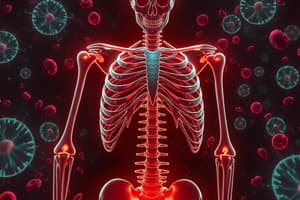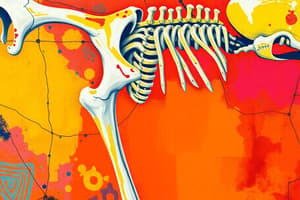Podcast
Questions and Answers
What is the function of red bone marrow in adults?
What is the function of red bone marrow in adults?
- Storing fat
- Mineral storage
- Producing new bone cells
- Producing blood cells (correct)
What is the central cavity of a long bone called?
What is the central cavity of a long bone called?
- Medullary cavity (correct)
- Cancellous space
- Haversian canal
- Lacunae
What type of tissue does osseous tissue belong to?
What type of tissue does osseous tissue belong to?
- Nervous tissue
- Epithelial tissue
- Muscle tissue
- Connective tissue (correct)
What is the process of dissolving bone and releasing its minerals to the bloodstream?
What is the process of dissolving bone and releasing its minerals to the bloodstream?
What are bone cells called before and after they become enclosed in lacunae?
What are bone cells called before and after they become enclosed in lacunae?
What type of bone structure includes trabeculae and spicules?
What type of bone structure includes trabeculae and spicules?
Which hormone is secreted in response to calcium deficiency?
Which hormone is secreted in response to calcium deficiency?
What is the deepest muscle of the abdominal wall?
What is the deepest muscle of the abdominal wall?
Which muscle is NOT part of the mastication muscles?
Which muscle is NOT part of the mastication muscles?
What does muscle extensibility refer to?
What does muscle extensibility refer to?
Which statement about skeletal muscle fibers is true?
Which statement about skeletal muscle fibers is true?
What is the relative position of the liver to the diaphragm?
What is the relative position of the liver to the diaphragm?
What describes the process of moving chemicals down a concentration gradient?
What describes the process of moving chemicals down a concentration gradient?
Which of the following statements about a dipeptide is correct?
Which of the following statements about a dipeptide is correct?
Which tissue type is not found in adult organs?
Which tissue type is not found in adult organs?
Which layer of skin is considered the most superficial?
Which layer of skin is considered the most superficial?
Which apical layer of epithelium features cells with varying heights on the same basement membrane?
Which apical layer of epithelium features cells with varying heights on the same basement membrane?
What type of membrane lines cavities that are open to the exterior environment?
What type of membrane lines cavities that are open to the exterior environment?
What is the primary role of the skeleton related to fat storage?
What is the primary role of the skeleton related to fat storage?
Which type of ossification produces flat bones, such as the skull?
Which type of ossification produces flat bones, such as the skull?
What term describes the outer covering of a long bone?
What term describes the outer covering of a long bone?
Which statement regarding epiphyseal plates in children is correct?
Which statement regarding epiphyseal plates in children is correct?
Which type of bone does a vertebra belong to?
Which type of bone does a vertebra belong to?
What is the role of red bone marrow in adults?
What is the role of red bone marrow in adults?
Which muscle is considered the prime mover during inhalation?
Which muscle is considered the prime mover during inhalation?
What is the main function of lysosomes in bone cells?
What is the main function of lysosomes in bone cells?
What is the position of the liver in relation to the diaphragm?
What is the position of the liver in relation to the diaphragm?
What does it mean for chemicals to move down a concentration gradient?
What does it mean for chemicals to move down a concentration gradient?
Which component of a feedback loop is responsible for detecting changes?
Which component of a feedback loop is responsible for detecting changes?
What is the most superficial layer of the skin?
What is the most superficial layer of the skin?
Which of the following statements about skeletal muscle fibers is correct?
Which of the following statements about skeletal muscle fibers is correct?
What type of epithelium most commonly makes up kidney tubules?
What type of epithelium most commonly makes up kidney tubules?
Which type of feedback occurs during hormonal stimulation of the uterus during childbirth?
Which type of feedback occurs during hormonal stimulation of the uterus during childbirth?
What is the name of the membrane lining cavities that are open to the external environment?
What is the name of the membrane lining cavities that are open to the external environment?
Which tissue is composed of similar cells and an extracellular matrix?
Which tissue is composed of similar cells and an extracellular matrix?
Which of the following correctly describes a dipeptide?
Which of the following correctly describes a dipeptide?
Which of the following is NOT a recognized function of the skeleton?
Which of the following is NOT a recognized function of the skeleton?
What type of ossification is responsible for the development of long bones?
What type of ossification is responsible for the development of long bones?
What is the primary role of the periosteum?
What is the primary role of the periosteum?
What are the cartilage areas at the epiphysis of a growing long bone known as?
What are the cartilage areas at the epiphysis of a growing long bone known as?
Which of the following bone cells is known to have the greatest number of lysosomes?
Which of the following bone cells is known to have the greatest number of lysosomes?
What structure connects the frontal and occipital bellies of the occipitofrontalis muscle?
What structure connects the frontal and occipital bellies of the occipitofrontalis muscle?
Which muscle is the antagonist to the triceps brachii?
Which muscle is the antagonist to the triceps brachii?
Which statement best describes the function of red bone marrow?
Which statement best describes the function of red bone marrow?
Which of the following muscles is included in the mastication muscles?
Which of the following muscles is included in the mastication muscles?
What tissue type is composed of similar cells and extracellular matrix?
What tissue type is composed of similar cells and extracellular matrix?
Which layer of skin is primarily responsible for the most rapid cell division?
Which layer of skin is primarily responsible for the most rapid cell division?
Which of the following structures is not part of the human digestive system?
Which of the following structures is not part of the human digestive system?
What is the primary role of ionic bonds in biological substances?
What is the primary role of ionic bonds in biological substances?
Which statement about the function of fibroblasts is correct?
Which statement about the function of fibroblasts is correct?
What term describes the clear gel-like substance found within a cell?
What term describes the clear gel-like substance found within a cell?
Which epithelium makes up most kidney tubules?
Which epithelium makes up most kidney tubules?
What is the scientific term for the study of the structure and function of cells?
What is the scientific term for the study of the structure and function of cells?
In which layer of the skin is melanin predominantly produced?
In which layer of the skin is melanin predominantly produced?
What type of bones are primarily produced through endochondral ossification?
What type of bones are primarily produced through endochondral ossification?
What role do the epiphyseal (growth) plates play in a child's hand x-ray?
What role do the epiphyseal (growth) plates play in a child's hand x-ray?
Which of the following statements is true regarding the periosteum?
Which of the following statements is true regarding the periosteum?
Which type of muscle prevents a bone from moving during an intentional action?
Which type of muscle prevents a bone from moving during an intentional action?
Which of the following is a characteristic of trabecular bone?
Which of the following is a characteristic of trabecular bone?
What type of muscle shows a parallel arrangement of its fibers?
What type of muscle shows a parallel arrangement of its fibers?
What is typically found within the marrow cavity of an adult humerus diaphysis?
What is typically found within the marrow cavity of an adult humerus diaphysis?
What is the primary role of red bone marrow in adults?
What is the primary role of red bone marrow in adults?
Which of the following muscles is associated with mastication?
Which of the following muscles is associated with mastication?
What best describes the structure of a tissue compared to a cell?
What best describes the structure of a tissue compared to a cell?
What is the anatomical position of the liver relative to the diaphragm?
What is the anatomical position of the liver relative to the diaphragm?
In the context of concentration gradients, what does it mean when chemicals move down a gradient?
In the context of concentration gradients, what does it mean when chemicals move down a gradient?
Which of the following statements about the diaphragm is correct?
Which of the following statements about the diaphragm is correct?
What is true about a hydrolysis reaction?
What is true about a hydrolysis reaction?
What is the scientific term for the clear gel inside a cell?
What is the scientific term for the clear gel inside a cell?
Which component is NOT a part of a feedback loop?
Which component is NOT a part of a feedback loop?
Which cells are responsible for producing cartilage matrix?
Which cells are responsible for producing cartilage matrix?
Which statement accurately describes a dipeptide?
Which statement accurately describes a dipeptide?
What is the role of periosteum in relation to bones?
What is the role of periosteum in relation to bones?
Which type of ossification is responsible for producing flat bones like those of the skull?
Which type of ossification is responsible for producing flat bones like those of the skull?
What type of tissue is formed by the growth of cartilage at the epiphyseal plates?
What type of tissue is formed by the growth of cartilage at the epiphyseal plates?
Which of the following statements is true regarding the structure of a vertebra?
Which of the following statements is true regarding the structure of a vertebra?
Which cartilage area is found at the epiphysis of a growing long bone?
Which cartilage area is found at the epiphysis of a growing long bone?
What is the role of fat storage in the skeletal system?
What is the role of fat storage in the skeletal system?
Which type of muscle is primarily responsible for voluntary movement?
Which type of muscle is primarily responsible for voluntary movement?
Which structure serves to anchor a thick filament to a Z disc?
Which structure serves to anchor a thick filament to a Z disc?
What term describes the condition of a muscle being able to stretch without damage?
What term describes the condition of a muscle being able to stretch without damage?
Which statement accurately describes skeletal muscle?
Which statement accurately describes skeletal muscle?
What defines a tissue as a group of similar cells performing a specific function?
What defines a tissue as a group of similar cells performing a specific function?
Which layer of skin houses the majority of sensory receptors?
Which layer of skin houses the majority of sensory receptors?
Which of the following is true regarding the frontal plane?
Which of the following is true regarding the frontal plane?
What is the primary function of auscultation?
What is the primary function of auscultation?
Which region of the abdomen is most lateral and superior?
Which region of the abdomen is most lateral and superior?
How does the temperature regulation ability of water contribute to homeostasis?
How does the temperature regulation ability of water contribute to homeostasis?
What type of feedback is involved in regulating the uterus during childbirth?
What type of feedback is involved in regulating the uterus during childbirth?
Flashcards
Function of the skeleton (RBC storage)
Function of the skeleton (RBC storage)
RBC storage is NOT a primary function of the skeleton.
Tissue type of osseous tissue
Tissue type of osseous tissue
Connective tissue
Central cavity of a long bone
Central cavity of a long bone
Marrow cavity
Bone type of a vertebra
Bone type of a vertebra
Signup and view all the flashcards
Sheath covering a long bone
Sheath covering a long bone
Signup and view all the flashcards
Bone cell before lacunae
Bone cell before lacunae
Signup and view all the flashcards
Bone cell with most lysosomes
Bone cell with most lysosomes
Signup and view all the flashcards
Bone type with trabeculae and spicules
Bone type with trabeculae and spicules
Signup and view all the flashcards
Mastication Muscles
Mastication Muscles
Signup and view all the flashcards
Muscle Extensibility
Muscle Extensibility
Signup and view all the flashcards
Voluntary Muscle
Voluntary Muscle
Signup and view all the flashcards
Skeletal Muscle Fiber
Skeletal Muscle Fiber
Signup and view all the flashcards
Myofilament in Thick Filament
Myofilament in Thick Filament
Signup and view all the flashcards
Components of a Feedback Loop
Components of a Feedback Loop
Signup and view all the flashcards
Frontal Plane
Frontal Plane
Signup and view all the flashcards
Liver Location
Liver Location
Signup and view all the flashcards
Study of Cell Structure & Function
Study of Cell Structure & Function
Signup and view all the flashcards
Concentration Gradient
Concentration Gradient
Signup and view all the flashcards
What are the mastication muscles?
What are the mastication muscles?
Signup and view all the flashcards
What is muscle extensibility?
What is muscle extensibility?
Signup and view all the flashcards
Why is skeletal muscle called voluntary?
Why is skeletal muscle called voluntary?
Signup and view all the flashcards
How many nuclei does a skeletal muscle fiber have?
How many nuclei does a skeletal muscle fiber have?
Signup and view all the flashcards
Identify the myofilament in the thick filament.
Identify the myofilament in the thick filament.
Signup and view all the flashcards
What are the components of a feedback loop?
What are the components of a feedback loop?
Signup and view all the flashcards
How does the frontal plane divide the body?
How does the frontal plane divide the body?
Signup and view all the flashcards
Where is the liver located?
Where is the liver located?
Signup and view all the flashcards
Mention the movement of chemicals down a concentration gradient.
Mention the movement of chemicals down a concentration gradient.
Signup and view all the flashcards
How is a tissue different from a cell?
How is a tissue different from a cell?
Signup and view all the flashcards
Cavity in a bone
Cavity in a bone
Signup and view all the flashcards
Muscle fiber arrangement
Muscle fiber arrangement
Signup and view all the flashcards
Muscle preventing movement
Muscle preventing movement
Signup and view all the flashcards
Prime mover for inhalation
Prime mover for inhalation
Signup and view all the flashcards
Deepest abdominal muscle
Deepest abdominal muscle
Signup and view all the flashcards
Longest muscle in the body
Longest muscle in the body
Signup and view all the flashcards
What is the skeletal system's function?
What is the skeletal system's function?
Signup and view all the flashcards
What type of tissue is bone?
What type of tissue is bone?
Signup and view all the flashcards
What is the central cavity of a long bone called?
What is the central cavity of a long bone called?
Signup and view all the flashcards
What type of bone is a vertebra?
What type of bone is a vertebra?
Signup and view all the flashcards
What are the coverings of a long bone?
What are the coverings of a long bone?
Signup and view all the flashcards
What are bone cells called before and after being enclosed in lacunae?
What are bone cells called before and after being enclosed in lacunae?
Signup and view all the flashcards
Which bone cell has the most lysosomes?
Which bone cell has the most lysosomes?
Signup and view all the flashcards
What is spongy bone characterized by?
What is spongy bone characterized by?
Signup and view all the flashcards
Movement Down Concentration Gradient
Movement Down Concentration Gradient
Signup and view all the flashcards
Tissue vs. Cell
Tissue vs. Cell
Signup and view all the flashcards
Bone Cell Types
Bone Cell Types
Signup and view all the flashcards
Spongy Bone Structure
Spongy Bone Structure
Signup and view all the flashcards
Bone Elongation
Bone Elongation
Signup and view all the flashcards
Bone Remodeling
Bone Remodeling
Signup and view all the flashcards
Prime Mover
Prime Mover
Signup and view all the flashcards
Muscle Antagonist
Muscle Antagonist
Signup and view all the flashcards
Muscle Fixator
Muscle Fixator
Signup and view all the flashcards
Myosin Filament
Myosin Filament
Signup and view all the flashcards
Feedback Loop Components
Feedback Loop Components
Signup and view all the flashcards
Growth Plate
Growth Plate
Signup and view all the flashcards
Prime Mover Muscle
Prime Mover Muscle
Signup and view all the flashcards
Study Notes
Skeletal System
-
Functions of the skeleton (RBC storage):
- Support
- Protection
- Movement
- Mineral storage
- Blood cell production
- Fat storage
-
Type of tissue osseous tissue belongs to: Connective tissue
-
Central cavity of a long bone: Medullary cavity
-
Type of bone a vertebra belongs to: Irregular bone
-
External sheath and lining of marrow cavity:
- Periosteum (external sheath)
- Endosteum (lining the marrow cavity)
-
Bone cells (before and after being enclosed):
- Osteoblasts (before)
- Osteocytes (after)
-
Bone cell with highest lysosome count: Osteoclasts
-
Bone type with trabeculae and spicules: Spongy bone
-
Red bone marrow function: Blood cell production (not new bone cell production)
-
Marrow cavity of adult humerus diaphysis: Yellow bone marrow
-
Bones produced by intramembranous ossification: Flat bones (e.g., skull bones)
-
Precursor connective tissue in endochondral ossification: Hyaline cartilage
-
Child's hand X-ray appearance: Epiphyseal plates (growth plates), not lines
-
Bone elongation source: Cartilage growth
-
Cartilage areas at epiphysis: Articular cartilage and epiphyseal plate cartilage
-
Bone dissolving/mineral return process: Bone resorption
-
Hormone response to calcium deficiency: Parathyroid hormone (PTH)
- Activates osteoclasts
-
Cavity in a bone: Sinus
-
Sutures location: Only between cranial bones
-
Study of muscular system: Myology
-
Secretion function of muscular system: No
-
Muscle fibers arranged in bundles: Fascicles
-
Muscle shape of rectus femoris: Parallel
-
Muscle preventing bone movement: Antagonist
-
Prime mover for inhalation: Diaphragm
-
Structure connecting occipitofrontalis bellies: Aponeurosis
-
Deepest abdominal muscle: Transversus abdominis
-
Antagonist to triceps brachii: Biceps brachii
-
Longest muscle in the human body: Sartorius
-
Teres muscle in SITS: Teres minor
-
Selected muscle part of quadriceps: Depends on the muscle in question
- Rectus femoris, vastus lateralis, vastus medialis, vastus intermedius
-
Selected muscle part of hamstrings: Depends on the muscle in question
-
Selected muscle part of mastication muscles: Depends on the muscle in question
- Masseter, temporalis, medial pterygoid, lateral pterygoid
-
Muscle extensibility: Ability to stretch
-
Voluntary skeletal muscle: Subject to conscious control
-
Skeletal muscle fiber nucleus: Single nucleus
-
Myofilament in thick filament core: Myosin
Other Body Systems
-
Feedback loop components: Stimulus, receptor, control center, effector, response
-
Frontal plane division: Anterior and posterior
-
Liver position relative to diaphragm: Inferior
-
Most lateral and superior abdominal region: Right hypochondriac region
-
Brain cavity: Cranial cavity
-
Auscultation definition: Listening to body sounds
-
Cellular structure study: Cytology
-
Chemical movement down a concentration gradient: Higher concentration to lower concentration
-
Tissue vs. cell:
- Tissue: Similar cells, extracellular matrix
- Cell: Organelles, cytoplasm, plasma membrane
-
Human structure levels (complex to simple): Organism, organ system, organ, tissue, cell, organelle, molecule, atom
-
Body structures (simple to complex): Atom → molecule → organelle → cell → tissue → organ → organ system → organism
- Group of similar cells in discrete region performing function = tissue
-
Feedback type during uterus hormonal stimulation: Positive feedback
-
Ionic bonds in water: Break apart more easily
-
Blood pH: Slightly basic (around 7.4)
-
Water's heat capacity: Effective coolant
-
Exchange reaction: Bonds broken and new ones formed
-
Opposite of dehydration synthesis: Hydrolysis
-
Dipeptide bonds: Two amino acids joined by one peptide bond
-
Atom with atomic number 11 and mass 23: 11 protons, 11 electrons, 12 neutrons
-
Atom chemical properties: Determined by valence electrons
-
Valence electrons in atom with atomic number 8: 6
-
Clear gel surrounding cells: Interstitial fluid
-
Tissue not found in adult organs: Embryonic tissue
-
Clear gel inside cell: Cytoplasm
-
Epithelial cells (ECM): Almost entirely cells, little ECM
-
Epithelium of kidney tubules: Cuboidal epithelium
-
Epithelium with varying heights: Pseudostratified columnar epithelium
-
Plasma cells and connective tissue matrix: Plasma cells do not produce connective tissue proper matrix
-
Cartilage and connective tissue matrix producers: Chondrocytes (cartilage) and fibroblasts (connective tissue)
-
Membrane lining cavities open to the exterior: Mucosa membrane
-
Vitamin D synthesis start: Skin
-
Deeper skin layer: Dermis
-
Youngest keratinocytes: Stratum basale
-
Skin color components: Melanin, hemoglobin, carotene
-
Skin component (not skin): Hypodermis
-
Most superficial skin layer: Stratum corneum
-
Primary skin color factors: Melanocytes
-
Major epidermal layer: Stratum spinosum(75%)
-
Fastest mitosis skin layer: Stratum basale
Studying That Suits You
Use AI to generate personalized quizzes and flashcards to suit your learning preferences.
Description
Test your knowledge on the skeletal system and its functions, including the types of tissues, bone structures, and cell types involved in bone health. This quiz covers key concepts such as the roles of bones in support, protection, and blood cell production.




